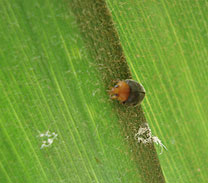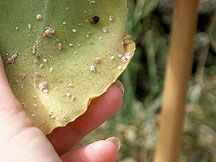The E.W. Heier Teaching Greenhouse has been utilizing beneficial insects for insect pest control since 2008. The E. W. Heier Teaching Greenhouse was selected by the Broome County Legislature to be recognized in the 2009 Green Business Initiatives for "exemplary leadership and innovative practice to improve and protect our environment, and for instituting a policy in which beneficial insects are used as a means of pest control. The E.W. Heier Teaching Greenhouse has, through their research, advanced the field of non-chemical pesticides, which will benefit the people of Broome County and beyond."
Biological Pest Control
In February of 2008 we started the introduction of beneficial insects into the E.W.Heier Teaching Greenhouse for biological pest control. Biological pest control is the use of an organism to attack harmful insects. They could be predators, parasites, or even diseases.

We started with four species of beneficial insects, which are any insect that preys on a harmful insect in the greenhouse. We chose to start with a parasitic wasp for our sweet potato whitefly - Eretmocerus; a parasitic spider mite for our two-spotted spider mite - P. persimilis; the Mealy Bug Destroyer beetle for our mealybug - Cryptolaemus montrouzieri; and the lacewing larvae for the mealybug - C. rufilabris.

Why Use Beneficial Insects? Crypt Larvae & Mealybugs. Both adult & larval crypts feed on mealybugs. We primarily released them into the Warm Temperate Room. Releases throughout the greenhouse are scheduled for September.
Overtime many pests can become resistant to chemical pesticides, rendering them ineffective.
Prolonged exposure to pesticides is harmful for the applicant and the pesticides leave
a residue on the plant. Initial costs of beneficials may exceed pesticide costs, but
over time the costs for pest control with beneficials is far below that of pesticides.
We are striving for a clean, green friendly environment with a self sustaining beneficial
population.
Initial & On-going Results of Beneficials
Crypt adult after release into the Desert Room. It is surrounded by plenty of food - egg masses of the citrus mealybug as well as adult citrus mealybug.

Our population of sweet potato whiteflies has decreased noticeably after the introduction of the Eretmocerus to selected infested plants. Our whitefly populations fluctuate depending on the season and the plants overwintering in the cool temperate zone.Presently we are working to control greenhouse whiteflies with Encarsia.
The very tiny parasitic mite, P. persimilis appears to have cleared up signs of two-spotted mites on the selected plants it was scattered over. These cannot be seen with the naked eye so determining a present population is harder to do. We routinely introduce more parasitic mites.
The most noticeable are the Crypts - Cryptolaemus. These tropical lady bug beetles did remain in the greenhouse after release and we discovered many crypt larvae among the plants in the Warm Temperate and the Desert Rooms. We watched them develop through their 3 enstars. The forming adults in the Desert Room appeared to have been halted in their development - possibly due to low humidity levels. We routinely introduce crypt beetles to all the houses. The cycads remain our primary mealybug targets.
In 2007 the staff made 72 full-facility pesticide applications in the Teaching Greenhouse. In 2021 that number is now ZERO! A spot spray was last made in 2017!!!